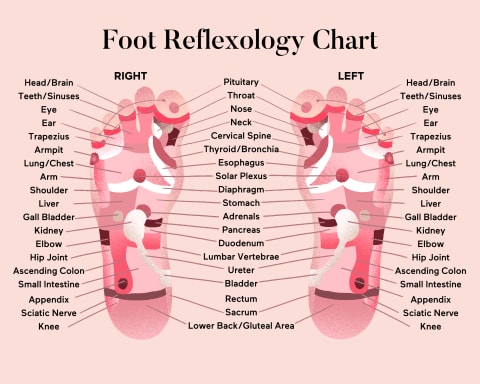Since it’s such a relaxing practice, reflexology can make a great addition to any bedtime ritual. Get started with this 15-minute reflexology routine that corresponds to body parts that are important for sleep. In many ways, this chart is thousands of years in the making: There is evidence suggesting that people practiced early forms of reflexology as far back as 2330 B.C.1 Today, the practice is most popular in Eastern medical fields such as Traditional Chinese Medicine and Ayurveda and it is easy enough to do regularly at home.
- To begin, sit in a comfortable position in a quiet room. Using a light, absorbent greaseless lotion, massage the feet with squeezing, stroking, kneading, and wringing motions.
- Next, cross your foot over your knee and hold the ankle firmly. Place the thumb of your other hand on the sole of that foot.
- On the bottom of the foot, “walk” your thumb up from the base of the heel to each toe (imagine your thumb is a caterpillar inching its way up your foot), then press these reflex points with the outer edge of your thumb or tip of your forefinger:
- Finish with another thumb press on the foot’s solar plexus point.
- End with “breeze strokes.” Lightly run your fingertips down the tops, bottoms, and sides of each foot in a feathery motion, barely touching the skin. Repeat this several times. It is very soothing to the nerves.
- Repeat the routine on your other foot. Since reflexology transports you into a state of deep relaxation where you are open to suggestions, this is a good time for a pre-sleep affirmation such as: “A kind and forgiving world sings me to a peaceful sleep.” Count your blessings and appreciate all of the good times in your day. Envision how you would like your next day to be before drifting asleep. While the scientific mechanisms involved in this process are not entirely clear, they might have to do with the peripheral nervous system, which connects our central nervous system (the brain and spinal cord) with the rest of the body and acts as a biological highway of sorts, sending signals between our limbs and brain. While more research needs to be done on reflexology2, preliminary studies show that it can help decrease systolic blood pressure3 and promote healthy circulation4. The safe, relaxing practice can be a complementary tool to other stress management strategies.



